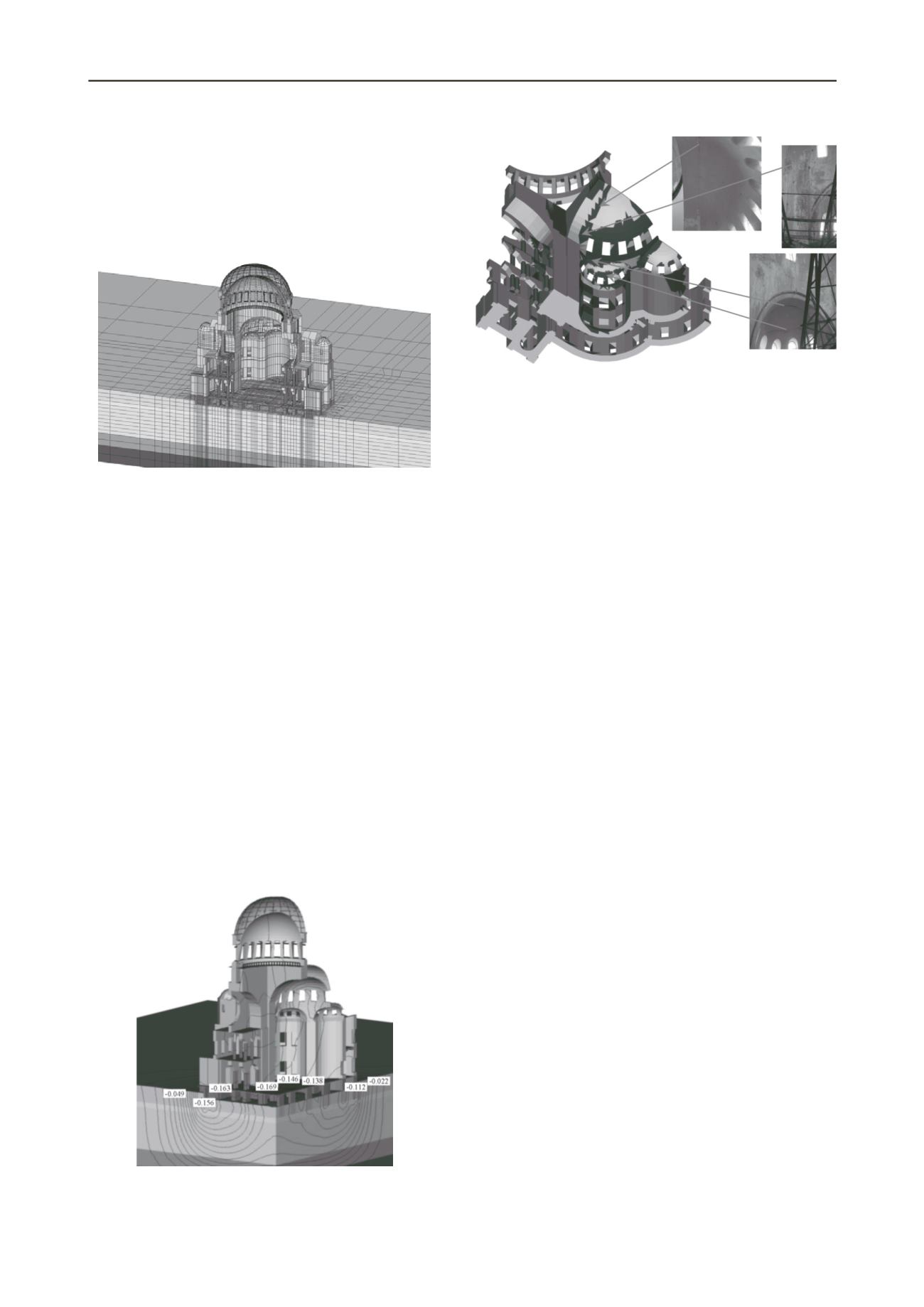
828
Proceedings of the 18
th
International Conference on Soil Mechanics and Geotechnical Engineering, Paris 2013
geophysical investigation was performed. Soil samples from the
holes were taken; main properties of soil were determined.
A series of soil-structure interaction computations has been.
The computation profile is shown in Fig. 7. All main structural
elements, foundations, and subsoil layers have been
incorporated in the computation profile. All main findings
during the condition survey of structural elements, foundations,
and subsoil have been taken into account in computations.
Fig. 9. Location of possible calculated cracks development and real
observed crack locations
The given example demonstrate that SSI calculations can
become an important tool in design practice, ensuring the most
effective design solutions without compromising overall safety
and reliability of buildings and structures.
Fig. 7. Computation profile of the cathedral
Soil-structure interaction calculations showed that the
cathedral is subject to non-uniform settlements. The reason of
these settlements is the different loads acting to the main
bearing structures of the Cathedral (Fig. 8-9). Such non-
uniformity of loads is quite typical for the temples characterized
by cross-cupola structural scheme. The most heavily loaded are
central pillars by which the central cupola is supported. Hence,
the pillars are subject to bigger settlements. The calculated non-
uniform settlements (Fig. 8) correspond well to the results of the
geodetic measurements. The observed settlement differential is
about 13-22 mm.
6 CONCLUSIONS
1. Proper engineering account made of soil-structure interaction
is essential not only for unique projects but also for run-of-the-
mill buildings and structures. Analyses of typical buildings’
layouts show that SSI computation may reveal stress increases
exceeding 4-times the stresses computed for rigid subsoils.
Computations show that the zones of development of tensile
stresses in brickwork well agree with the locations of actual
cracks. In particular, taking into account non-uniform settlements
we have a characteristic system of cracks in the semi-domes in
altar and Western parts of the Cathedral (Fig. 9).
2. Application of soil-structure interaction analyses in design
practice is associated with a number of problems, which can be
mostly resolved by means of
FEM models 3.0
release. The
former releases of the software used by Georeconstruction
Institute in their design practice for 10 years revealed efficiency
of the unified approach towards combined soil-structure
modelling within a single software package.
The main conclusion of the conducted investigations and SSI
computations is that currently there is no danger of an
immediate collapse of the Cathedral. Local mostly endangered
structural elements are: the main dome, its supporting elements
and semi-domes in Eastern and Western parts of the cathedral.
Local reinforcement must be provided as soon as possible. This
reinforcement must be based on the detailed analysis.
3. The algorithm for solution of non-linear equation systems
targeted at cracking highly complex non-linear SSI problems
does not contain an enclosed cycle for solution of linear
subproblem while tackling a linear problem, which significantly
reduces solution time. Convergence of the algorithm is proved
for rather general and relatively easily met conditions.
General strengthening of the monument was executed on the
basis of SSI computations as required both by local codes (TSN
50-302-2004) and International codes.
4. The offered non-linear soil model is able to accommodate
strain hardening anisotropy, which feature is of high importance
for soil-structure interaction analyses used for design of
buildings with a complex underground section.
7 REFERENCES
Golub G., Van Loan, Ch. 1999.
Matrix Computations.
Moscow, Mir
Publishers.
Munksgaard, N. 1980. Solving Sparse Symmetric Sets of Linear
Equations by Preconditioned Conjugate Gradients,
ACM
Transactions on Mathematical Software (TOMS)
, Vol. 6 No. 2, pp.
206-219
Shashkin, A.G. 2010a. Critical analyses of most widely used non-linear
soil models.
Engineering Geology.
Moscow. No 3,. pp. 29-37 (in
Russian)
Shashkin, A.G. 2010b. Depicting deformation behavior of clay soil with
visco-elasto-plastic mdel.
Engineering Geology.
Moscow. No 4,.
pp. 22-32 (in Russian)
Shewchuk J.A. 1994. An Introduction to the Conjugate Gradient
Method Without the Agonizing Pain
Voevodin, V.V. and Kuznetsov, Yu.A. 1984.
Matrix and calculations.
Moscow. Science Publishers (in Russian)
Wolfe, P. 1969. Convergence conditions for ascent methods.
SIAM
Rev.
11 (2), pp. 226–235.
Fig. 8. Contours of computed of settlements of the Cathedral, cm


